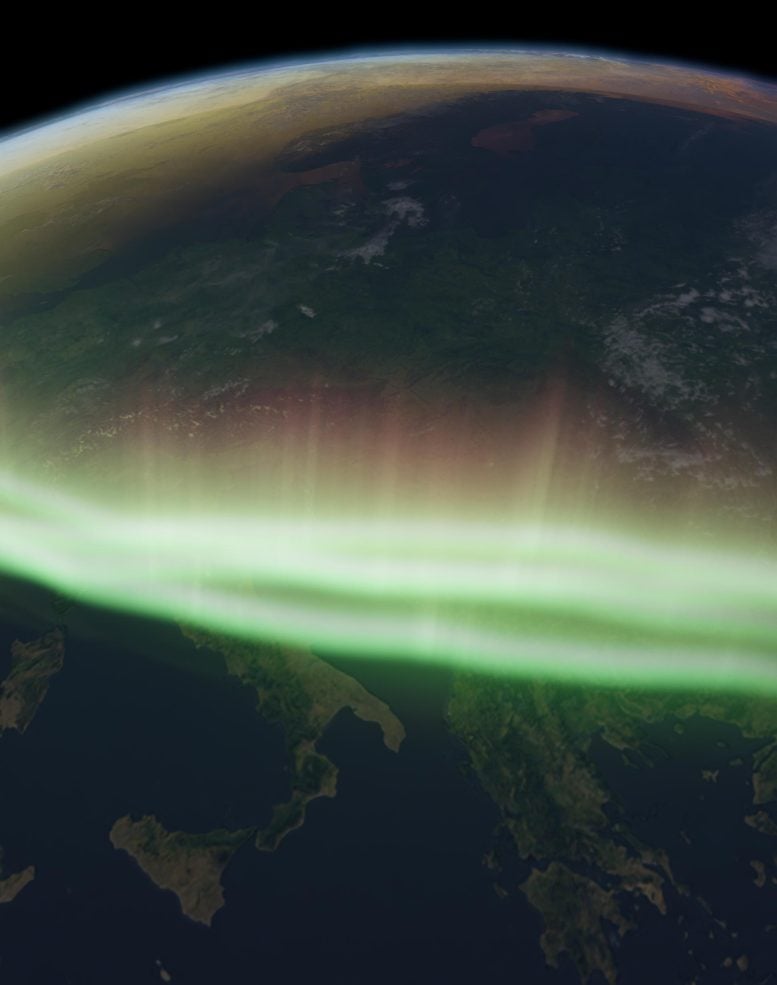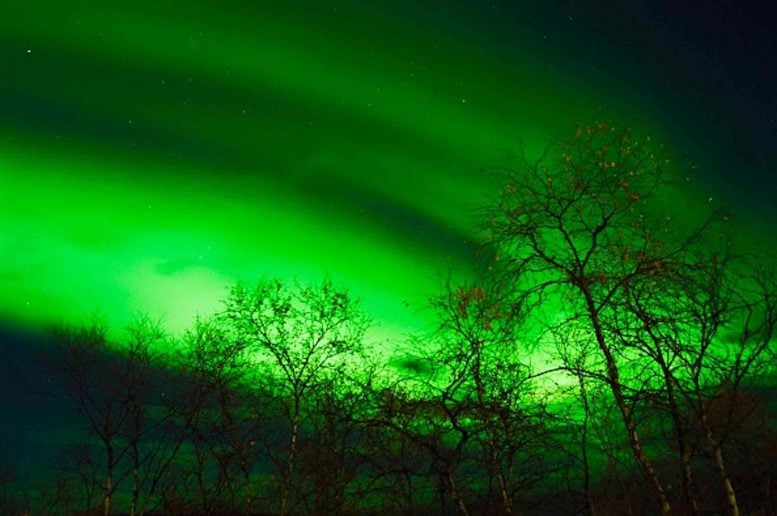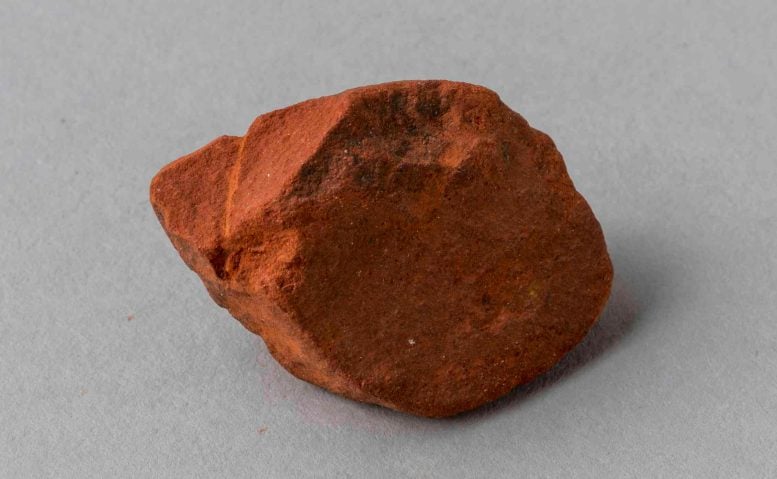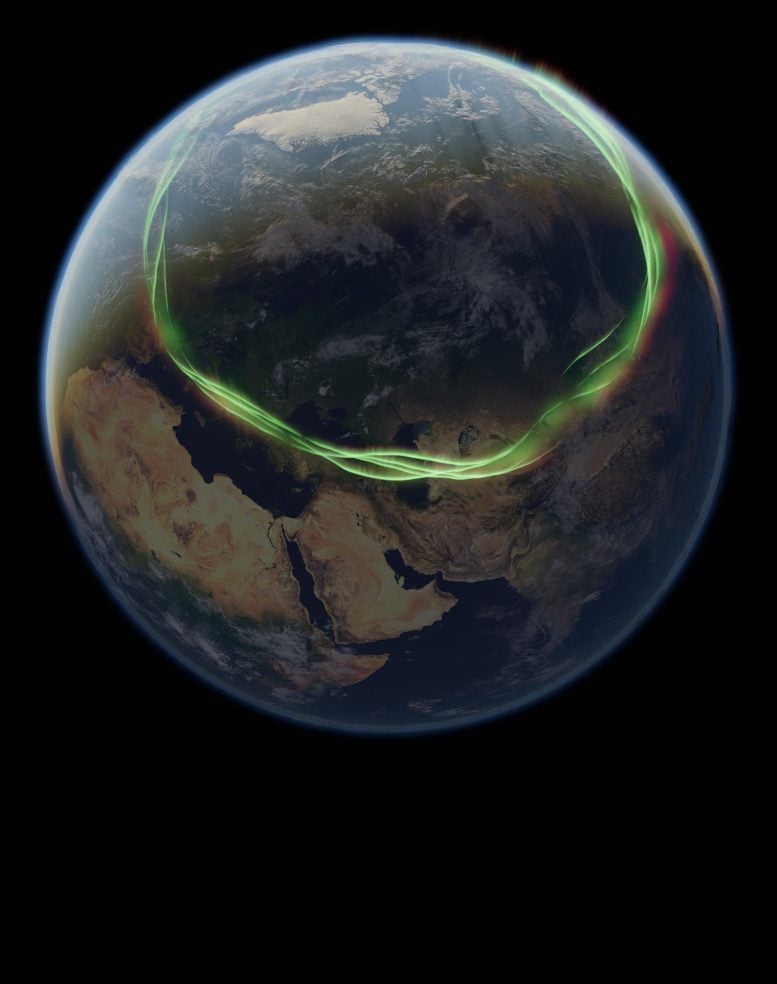
Weak magnetic fields once exposed humans to radiation. People adapted with shelter, clothing, and mineral protection.
Our first meeting was a bit awkward. One of us is an archaeologist who studies how past peoples interacted with their environments. Two of us are geophysicists who investigate interactions between solar activity and Earth’s magnetic field.
When we first got together, we wondered whether our unconventional project, linking space weather and human behavior, could actually bridge such a vast disciplinary divide. Now, two years on, we believe the payoffs – personal, professional and scientific – were well worth the initial discomfort.
Our collaboration, which culminated in a recent paper in the journal Science Advances, began with a single question: What happened to life on Earth when the planet’s magnetic field nearly collapsed roughly 41,000 years ago?
Weirdness when Earth’s magnetic shield falters
The event is known as the Laschamps Excursion, a short but intense geomagnetic disruption named after volcanic deposits in France where it was first discovered. Near the end of the Pleistocene epoch, Earth’s magnetic poles did not undergo a full reversal, as they typically do every few hundred thousand years. Instead, they shifted erratically across thousands of miles, while the strength of the magnetic field fell to less than 10% of its present level.

Under normal conditions, Earth’s magnetic field behaves like a stable dipole, similar to a bar magnet. During the Laschamps Excursion, however, it broke apart into several weaker poles scattered across the globe. This fragmentation weakened the magnetosphere, Earth’s natural shield that normally blocks much of the solar wind and harmful ultraviolet radiation from reaching the surface.
With the magnetosphere compromised, models suggest that a variety of near-Earth effects would have occurred. Auroras, which today are usually confined to the polar regions, likely appeared much closer to the equator, and the planet was exposed to significantly higher levels of solar radiation than we experience now.
The skies some 41,000 years ago may therefore have been both dazzling and dangerous. Recognizing this, we as geophysicists began to wonder how such conditions might have influenced human populations of the time.
From an archaeological perspective, the answer was clear: they were indeed affected.
Human responses to ancient space weather
For people living during this period, the auroras would likely have been the most visible and dramatic consequence, perhaps provoking awe, fear, ritual practices, or other responses that are difficult to trace. The archaeological record rarely preserves direct evidence of such emotional or cognitive reactions.
The physiological consequences of heightened ultraviolet exposure, however, are easier to assess. With the magnetic field weakened, more harmful radiation reached the surface, increasing the risks of sunburn, vision damage, birth defects, and other health concerns.

In response, people may have adopted practical measures: spending more time in caves, producing tailored clothing for better coverage, or applying mineral pigment “sunscreen” made of ochre to their skin. As we describe in our recent paper, the frequency of these behaviors indeed appears to have increased across parts of Europe, where effects of the Laschamps Excursion were pronounced and prolonged.
During this time, both Neanderthals and Homo sapiens inhabited Europe, though their ranges likely overlapped only in certain regions. Archaeological findings indicate that these populations responded differently to environmental pressures, with some relying more heavily on shelter or material culture as forms of protection.
It is important to emphasize that the research does not claim space weather alone drove these changes in behavior, nor that the Laschamps event was responsible for Neanderthal extinction—a common misinterpretation. Instead, it may have been one of several factors, an unseen but influential force shaping human adaptation and innovation.
Cross-discipline collaboration
Collaborating across such a disciplinary gap was, at first, daunting. But it turned out to be deeply rewarding.
Archaeologists are used to reconstructing now-invisible phenomena like climate. We can’t measure past temperatures or precipitation directly, but they’ve left traces for us to interpret if we know where and how to look.
But even archaeologists who’ve spent years studying the effects of climate on past behaviors and technologies may not have considered the effects of the geomagnetic field and space weather. These effects, too, are invisible, powerful and best understood through indirect evidence and modeling. Archaeologists can treat space weather as a vital component of Earth’s environmental history and future forecasting.

Likewise, geophysicists, who typically work with large datasets, models and simulations, may not always engage with some of the stakes of space weather. Archaeology adds a human dimension to the science. It reminds us that the effects of space weather don’t stop at the ionosphere. They can ripple down into the lived experiences of people on the ground, influencing how they adapt, create and survive.
The Laschamps Excursion wasn’t a fluke or a one-off. Similar disruptions of Earth’s magnetic field have happened before and will happen again. Understanding how ancient humans responded can provide insight into how future events might affect our world – and perhaps even help us prepare.
Our unconventional collaboration has shown us how much we can learn, how our perspective changes, when we cross disciplinary boundaries. Space may be vast, but it connects us all. And sometimes, building a bridge between Earth and space starts with the smallest things, such as ochre, or a coat, or even sunscreen.
Reference: “Wandering of the auroral oval 41,000 years ago” by Agnit Mukhopadhyay, Sanja Panovska, Raven Garvey, Michael W. Liemohn, Natalia Ganjushkina, Austin Brenner, Ilya Usoskin, Mikhail Balikhin and Daniel T. Welling, 16 April 2025, Science Advances.
DOI: 10.1126/sciadv.adq7275
Adapted from an article originally published in The Conversation.![]()
Agnit Mukhopadhyay has received funding from NASA Science Mission Directorate and the University of Michigan Rackham Graduate School.
Raven Garvey and Sanja Panovska do not work for, consult, own shares in or receive funding from any company or organization that would benefit from this article, and have disclosed no relevant affiliations beyond their academic appointment.
Never miss a breakthrough: Join the SciTechDaily newsletter.
36 Comments
I’m fascinated!! I would love to learn more, but I also want to know about the creditability of this website because I have only found it online. Who are the experts that recommend this source!!
The SciTechDaily science news aggregation site is commercial. As these things go, it isn’t entirely bad – follow the “About” link to see a self description that includes web awards for science.
Usually they post university press releases – or science popularizer’s take – on a paper. In this case they reposted a Conversation piece from the paper’s authors, so your credulity mileage may vary.
It is always better to go to the source paper and check the basics. Is it a credible journal – Science Advances is, but it is also posting papers that propose new hypotheses that may be thin (or fringe). Is it a peer reviewed paper – yes. If you have the chops for it, browse the paper and verify that e.g. the references support what they claim they do – not in this case, as far as I can see.
(But you should make up your own mind on the paper content.)
I want to get the knowledge
I want to get the knowledge I want to increasing knowledge
Why you choose meteorid travel?
Perhaps that is why people lived in deep dark caves painting the walls for amusement………
Obviously, just a day ago on a cruise ship their were a group of people that resembled baboon’s fighting jumping on and over things and betting on one person. Not only yesterday but often you hear about the same thing happening in Europe and same people.
What else was happening 41,000 years ago? End of ice age, migration across land bridges, and more. Put all the factors out there so we can see them.
41,000 years ago was during the last glacial, which ended about 11,700 years ago. [Wikipedia] Check your supposedly missing context yourself, the article is describing a paper that may (or may not) have sufficient context.
Does the timing match the extinction of mega fauna in Aussie?
Aboriginals probably killed them off. I read that years ago.
I visited Wellington Caves in NSW, Australia (not far from Dubbo) & there is a statue of a really huge wombat, I started reading about it.
Not really. “The term Australian megafauna refers to the megafauna in Australia[1] during the Pleistocene Epoch. Most of these species became extinct during the latter half of the Pleistocene, as part of the broader global Late Quaternary extinction event. The roles of human and climatic factors in their extinction are contested.” [Wikipedia]
“Earth’s natural shield that normally blocks much of the solar wind and harmful ultraviolet radiation from reaching the surface.”
The magnetosphere deflects charged particles (i.e. Coronal Mass Ejections), but has no effect on electromagnetic radiation such as sunlight and UV Electromagnetic Radiation.
While ozone is diamagnetic, meaning that it is repulsed by a non-uniform magnetic field, it is a very weak force. Without knowing exactly where the alleged magnetic centers were located, for how long, and their strength, it is only speculation as to the effect on ozone. Also, most ozone is generated in the tropics, where the magnetic field is nearly uniform, and migrates pole-wards through Brewer-Dobson circulation. I will speculate that the rate of migration of tropical stratospheric ozone might have been increased in the absence of a converging polar dipole impeding the tropical ozone.
“With the magnetic field weakened, more harmful radiation reached the surface, increasing the risks of sunburn, vision damage, birth defects, and other health concerns.”
No evidence is presented for increased UV reaching the surface. The background gamma radiation may have increased as a result of high-energy particles causing Compton scattering as they hit the upper atmosphere. However, while it is assumed that stratospheric ozone modulates the surface flux of UV, it is very likely that ozone would be generated in the upper-troposphere by the fugitive UV that makes it through the former ozone layer, should it be destroyed. The UV would be destroyed, and the ozone would have an even shorter life than currently. There probably would have been heating in the upper-troposphere, and thus a change in climate. However, no compelling mechanism for sunburning and blinding is provided by the authors.
The Conversation has a reputation for liberal-leaning political bias. But this is the first instance I have seen where even their basic science is questionable. This article reminds me of the famous quip by Mark Twain:
“There is something fascinating about science. One gets such wholesale returns of conjecture out of such a trifling investment of fact.”
I’m not impressed by the results of the touted collaboration.
Agree, The Conversation is akin to Medium, The AAAS Science article states the research was funded partly by NSF. At least they did state their biases and limitations: “We can’t measure past temperatures or precipitation directly, but they’ve left traces for us to interpret if we know where and how to look.”
Irrelevant on NSF, which is an independent federal agency that supports science and engineering in all 50 states and U.S. territories.
I do image processing for x-ray data. The rule is one image looks good (or bad) can not be qualified as a decision. There is a waste of work here.
Technically, ozone is not a “force”. But I agree, they didn’t care about UV light directly. They refer to cosmic ray references and to papers that claim long term 10-15 % drops in ozone (and the same increase in UV).
Please refrain from inserting your US politics into a neutral science site. It is science that is open to new ideas and thus is liberal at its core.
“…Please refrain…”? Good luck with that. You’ve been on this platform long enough to know that won’t happen.
So, you have proffered a tottering pile of Just So* reasoning? I would wonder why, but your pivot to an unsupported, deeply irrelevant, allegation of political bias is evidence of a kind too.
Here you go- a peer reviewed proposed mechanism of chemoatmospheric reaction chains for the linkage between the Laschamps and other excursions to increased UV surface radiation levels.
This is a place for science, not weaponzing science in service to your personal biases.
Sincerely, A Liberal.
https://www.pnas.org/doi/10.1073/pnas.2321770121
This article doesn’t mention what might have been happening in the southern hemisphere during this time.
Would it be worth examining some of the oral histories of our native Australians?
Might this explain why they began to paint their bodies with ochre and pipe clay, or even the origin of their Rainbow Serpent stories?
There is always a chance that oral histories contain some unique knowledge in them. The problem is finding evidence to make it more than speculation.
Some questions to ask, is why do some tribes in Africa still use ochre, but not all? Why ochre when a white pigment would help keep them cooler and would probably be a better sunscreen? Why cover the skin with something that might impede their sweating instead of weaving a light fabric of vegetable matter? If all humans used a natural ‘sunscreen’ 41,000 years ago, how did anyone know it would be safe to stop using it?
Unfortunately, the earth wasn’t around 41k years ago. The wild “theories” are nothing but exactly that. Funny how humans have supposedly been evolved from monkeys for 300k years, yet all of the technological breakthroughs have only happened over the last few thousand years?!?! You know how ridiculous that sounds? Way more ridiculous than not believing there’s a God who created everything.
Assumingly science approach and belief approach just a pretending to be. One w data One w no data but psychology(?)
If God created everything, then does that mean that God created itself?
You need to familiarize yourself with the Theory of Evolution before you spout off. Hint: it doesn’t say we evolved from monkeys. You’re embarassing yourself.
I ain’t never seen no monkey turn into a human at the zoo
That is another problem with their hypothesis, since the effect was mostly localized to the Northern latitudes. (E.g. the auroras.)
You mean, except for the non-polar configurations near the South Pole during the peak of the LE? Directly described in the paper you are criticizing? Resulting in the Open magnetic field configuration which would result in higher Aurora activity visible to Aboriginal peoples at the time?
“Notably, the dipole tilt was higher during this epoch, offset by the emergence of nondipolar configurations near the southern geographic pole, leading to a further broadening of the open-closed field line boundary.”
“Rainbow Serpent” is fabulous catch in terms of Telestic Exigesis. Well spotted.
(Given how much more advanced Pacific maritime tech and cultural flows were than previously realized, I would also look to Meso-and South American indigenous cultures for body paint, cave and cenote dwelling, and rainbow* serpents/dragons in the sky.
*Quetzalcoatl was feathered, but perhaps also relevant.
HOW LONG DID LAST THE
Laschamps Excursion period ???
The field excursion was about 2,000 years (but the “null” field switch was only a few hundred years).
The hypothesis is based on cherry picked circumstantial and hypothesis conflicting evidence which amounts to p hacking of only using data that fits the hypothesis. They have not studied any evidence for increased UV and its effects on the biosphere, they instead refer to an increase in cosmic radiation.
The main evidences is claimed to be an increased incidence in use of assumedly UV protecting ochre despite the darker skin color of hominins at the time. And some hominin groups disappearance (which they admit could be multifactorial). There is also some speculation in improved clothing technology, but that was a long term trend.
The ochre evidence is picked from a 2019 geophysicist paper advancing the same non-biologist hypothesis and some opposite evidence – only one of the current authors is an anthropologist. That paper claimed fair instead of the current paper dark skins and simply stated that ochre had a long history, not any increased use. That is inconsistent with the hypothesis.
For reference, I found an ozone model paper that claims ozone long term dropped 10-15 % which meant UV increased 10-15 % according to them.
Every 1,000 meter in height corresponds to about 10 % UV increase [WHO]. So for example the Tibetan plateau has an average 4,500 meter elevation and the people that lives there see about twice the UV we see.
Reference (also used by the discussed paper): https://www.science.org/doi/10.1126/science.abb8677 .